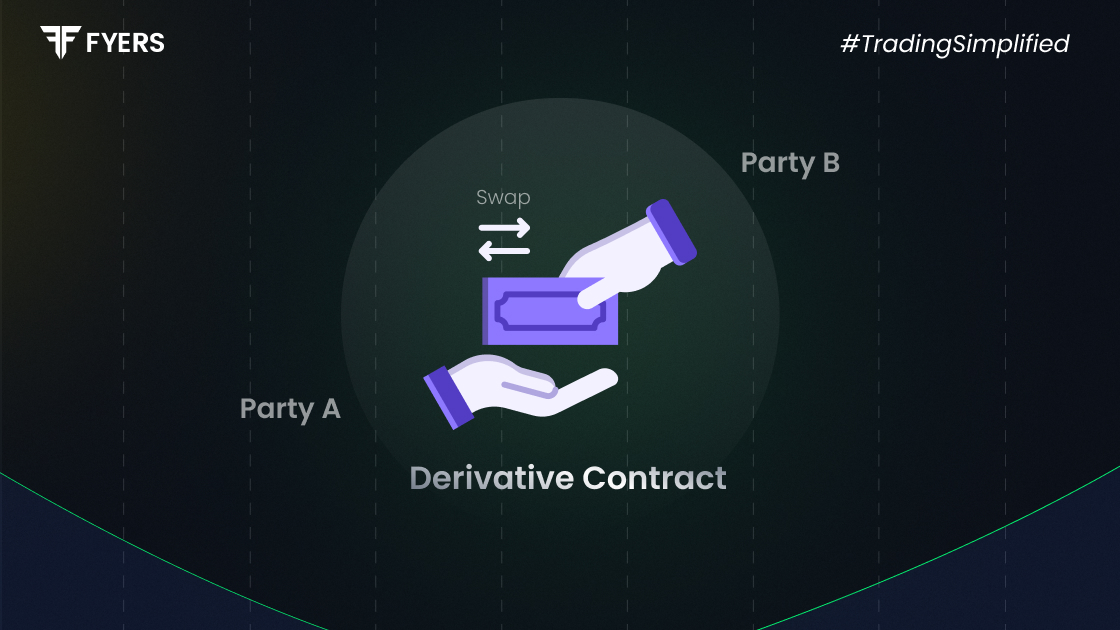

 30 Jul, 2025
30 Jul, 2025
 4 mins read
4 mins read

Swaps derivatives are powerful financial instruments used extensively in global markets. Though often considered complex, they play a vital role in risk management, interest rate hedging, and enhancing returns. From corporates to institutional investors, swaps are critical tools in modern finance.
In this article, we’ll break down what swaps are, explore the types of swaps, discuss how the swap market functions, and explain key terms like the swap curve and swap auction—all in simple, practical language.
A swap derivative is a contract between two parties to exchange sets of future cash flows over a specified time. These flows are typically based on interest rates, currencies, or commodity prices. The idea is to "swap" exposure—hence the name.
Swaps are classified as over-the-counter (OTC) derivatives, meaning they are privately negotiated and not traded on formal exchanges. They help institutions manage specific financial risks, such as fluctuating interest rates or currency values.
There are several types of swaps, each tailored to different financial needs:
The most common type. Here, parties exchange fixed-rate interest payments for floating-rate payments (or vice versa). This allows a firm with a fixed-rate loan to benefit from falling interest rates without refinancing.
Two parties exchange principal and interest payments in different currencies. It’s often used by multinational firms to manage foreign exchange risk.
Used to hedge price risk in commodities like oil, natural gas, or agricultural products.
A buyer pays a premium to protect against the default of a borrower. If the borrower defaults, the seller compensates the buyer.
Each type of swap serves a unique function in reducing financial risk or locking in future costs.
The swap market operates mainly through banks, financial institutions, and corporate entities. Since most swaps are customised contracts, they are traded in OTC markets rather than on stock exchanges.
Here’s how a typical swap works:
Negotiation: Two parties define terms—type, notional amount, duration, and payment schedule.
Execution: The contract is executed, and periodic payments are made as agreed.
Settlement: The parties exchange the net difference, usually through clearing mechanisms or directly.
The swap market has grown significantly, forming a vital component of global finance for risk management and speculation.
The swap curve is a graphical representation of swap rates across various maturities. It’s similar to a yield curve but is derived from interest rate swaps rather than government bonds.
Benchmarking: Many institutions use the swap curve instead of government bond yields to price corporate debt.
Interest Rate Forecasting: The shape of the curve reflects market expectations of future interest rates.
Valuation Tool: Helps in valuing long-term liabilities and financial instruments.
A steep swap curve suggests higher expected rates in the future, while a flat or inverted curve may indicate economic slowdown or uncertainty.
Swap auctions are formal bidding processes conducted by central banks or financial intermediaries to distribute swap lines or liquidity facilities. These are particularly crucial during times of market stress.
For example, central banks might hold a USD-INR swap auction to provide dollar liquidity to domestic banks. Participants bid for the swap amount and agree on a premium, which is determined through auction mechanisms.
Such auctions bring transparency and price discovery to an otherwise opaque OTC market.
Risk Hedging: Protects against adverse movements in interest rates, currencies, or commodity prices.
Customisation: OTC nature allows swaps to be tailored to specific needs.
Cost Efficiency: Often cheaper than issuing new debt or refinancing existing obligations.
Access to Foreign Markets: Currency swaps enable firms to raise capital in one currency and repay in another.
These benefits of swaps make them indispensable tools in financial planning and corporate treasury management.
A company with a floating-rate loan expects rates to rise. It enters an interest rate swap to pay a fixed rate instead, locking in costs.
An Indian firm raising funds in dollars uses a currency swap to convert debt into rupees, mitigating foreign exchange risk.
Banks use credit default swaps to offload credit risk associated with corporate loans.
These examples demonstrate how swaps derivatives are embedded in the day-to-day functioning of financial markets.
Despite their advantages, swaps come with risks:
Counterparty Risk: Since swaps are OTC contracts, there’s a risk the other party may default.
Complexity: Understanding and managing swaps require financial expertise.
Liquidity Risk: Some swap contracts can be illiquid, making it difficult to exit.
Regulatory Oversight: Although improving, the OTC nature of swaps means less transparency than exchange-traded instruments.
Investors and institutions must conduct thorough due diligence before entering swap agreements.
Swaps derivatives are essential instruments for risk management, strategic planning, and financial flexibility. While they may seem complex at first, understanding types of swaps, the swap market, and tools like the swap curve can empower both institutional and informed retail investors.
As global markets evolve, swaps will continue playing a crucial role in driving efficiency and innovation across interest rate, currency, and credit markets.
Swaps derivatives are financial contracts where two parties agree to exchange sets of cash flows over time, often to manage interest rate or currency risks.
The key types include interest rate swaps, currency swaps, commodity swaps, and credit default swaps.
The swap curve shows swap rates across different maturities and is used for pricing, forecasting interest rates, and benchmarking.
A swap auction is a bidding process where financial institutions or central banks offer swap lines or liquidity, allowing participants to access currency or funding under defined terms.
Calculate your Net P&L after deducting all the charges like Tax, Brokerage, etc.
Find your required margin.
Calculate the average price you paid for a stock and determine your total cost.
Estimate your investment growth. Calculate potential returns on one-time investments.
Forecast your investment returns. Understand potential growth with regular contributions.